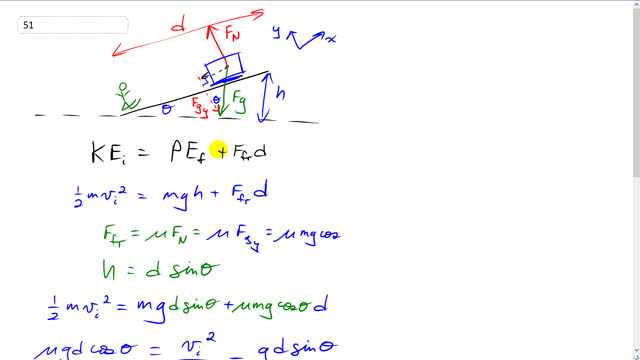
A skier traveling 11.0 m/s reaches the foot of a steady upward incline and glides 15 m up along this slope before coming to rest. What was the average coefficient of friction?

In order to watch this solution you need to have a subscription.
This is Giancoli Answers with Mr. Dychko. So, this gear approaches this 19 degree incline with some speed, 11 meters per second and it's like this box -- we're gonna draw a free-body diagram, as though they are a box -- and as they are going up the slope, there's some component of gravity in black which is going down the slope. And there's also force of friction, which I forgot to draw here; that's quite important. Force of friction is going along the slope against their direction of movement. And there's a normal force perpendicular to the slope and all of their kinetic energy that they have to begin with is gonna get turned into potential energy due to their increase in altitude, gravitational potential energy and that initial kinetic energy is also gonna get turned into heat due to this friction. And the amount of energy lost due to friction is gonna be the force of friction times the distance over which it acts so that's the distance along the slope. Now, we can substitute for the kinetic energy, one-half mv initial squared and then the final potential energy is gonna be force gravity, mg times the vertical change in height, h. And so we'll make expressions to substitute into here; we have force of friction is µF N and then the normal force has to equal the component of gravity perpendicular to the slope because there's no acceleration perpendicular to the slope. And so we can substitute F g y in place of F N and then F g y is the force of gravity here times cos Θ because this y-component is the adjacent leg of this triangle, adjacent to the angle Θ there and mg is F g, the hypotenuse of the triangle. h is d sin Θ because d is the distance it goes along the slope so that's the hypotenuse and h is the opposite leg. So to find h, you go hypotenuse times sin Θ. And then we substitute each of those into this formula. So we have—force of friction— µm g cos Θ written there and then we have h, d sin Θ written here and then we do some algebra to solve for µ; the coefficient of friction that must be present in order to make all this work the way it's supposed to. So we have divide everything by m, the m cancels from every term. Bring this term to the other side so it becomes a minus and this term stays positive; switch the sides around and we have this µgdcos Θ on the left equals v initial squared over 2 minus gdsin Θ and then divide everything by gdcos Θ. So, here's gdcos Θ underneath that term and the gd canceled in this term and you are left with just a sin on top and on the bottom, you have cos and this is a trigonometric identity, which is tan Θ; you just have to remember that sin Θ divided by cos Θ always is tan Θ. So, µ then is v initial squared over 2gdcos Θ minus tan Θ and if you didn't like that step there of making this into tan Θ, you know, don't worry about it - you can just do sin of 19 divided by cos of 19 and you'll get the same answer. So, we plug in some numbers here; we get 11 squared divided by 2 times 9.8 meters per second squared times 15 meters times cos 19 minus tangent of 19 and you get 0.091 must be the coefficient of kinetic friction.